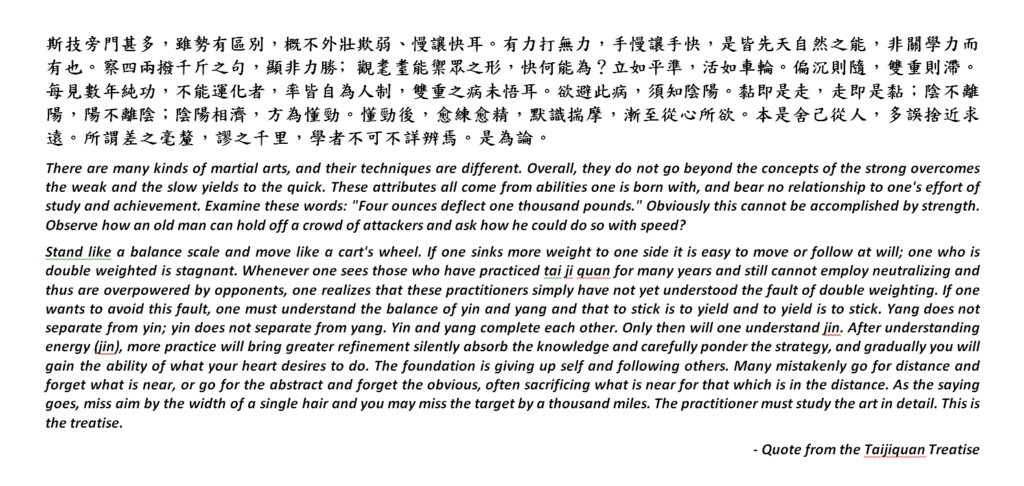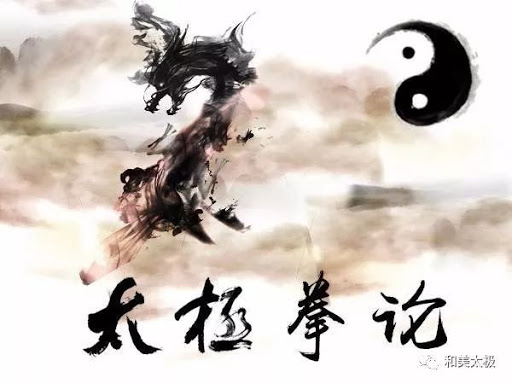
In the final two paragraphs of the treatise, it describes the end result of practicing tai chi correctly when following the principles which we have discussed in Parts 1 and 2 of this blog series. In these paragraphs tai chi as an internal art is compared to other martial arts which are based on external skills development. It lists some of the skills we want to refine and the common mistakes one makes on the journey of learning tai chi.
Tai Chi versus External Martial Arts
斯技旁門甚多,雖勢有區別,概不外壯欺弱、慢讓快耳。有力打無力,手慢讓手快,是皆先天自然之能,非關學力而有也。察四兩撥千斤之句,顯非力勝﹔觀耄耋能禦眾之形,快何能為?
There are many different types of martial arts. The differences lie primarily in the employment of different techniques. However, the fundamental skills of external martial artists remain the same. That is, they all train to be faster, stronger and fluent in their respective techniques.
This reliance on speed and strength means that the faster and stronger opponent wins. The physical human body has its limits. As we age, these physical attributes of speed and strength start to deteriorate. It is not external skills which make a tai chi master.
The tai chi saying and practice of “four ounces deflect a thousand pounds” obviously cannot be accomplished using brute strength. The tale of the “old man holding off a crowd of attackers” obviously cannot be accomplished based on speed. It is the internal martial arts skills which makes a tai chi master.
Tai Chi is an internal martial art. At its core, the martial arts philosophy of tai chi is fundamentally different from the other external martial arts. When training, there is no focus on physical speed and strength in tai chi. Instead, tai chi utilizes skills that draw upon the mind, our awareness of the body and our inner core strength. These attributes, in general, do not deteriorate with age as much as our external physical body.
Tai Chi Skills and Pitfalls
立如平準,活如車輪。偏沉則隨,雙重則滯。每見數年純功,不能運化者,率皆自為人制,雙重之病未悟耳。欲避此病,須知陰陽。黏即是走,走即是黏;陰不離陽,陽不離陰;陰陽相濟,方為懂勁。懂勁後,愈練愈精,默識揣摩,漸至從心所欲。本是舍己從人,多誤捨近求遠。所謂差之毫釐,謬之千里,學者不可不詳辨焉。是為論。
Posture
Posture is the first and most important skill to acquire in tai chi. “Stand like a balance scale” is to maintain a posture that is constantly balanced and aligned. This means “No inclination no leaning”, a concept which was explored in part 2 of the Taijiquan Treatise Explained series of blogs.
Agility in Movement
The next skill is to “move like a cart’s wheel”, that means movement in tai chi must be agile. To achieve this level of agility, weight needs to be placed over one point instead of two points. Just like a wheel which only ever has one point touching the ground and not two. The condition of “double weighting” causes sluggish movement which we often call “getting caught flat-footed”. This is a pitfall we learn to avoid in tai chi.
This agility allows one to follow and stick to the opponent at will. When we observe someone who has practiced tai chi for many years but still lacks the ability neutralize the opponent’s force, undoubtedly there is a lack of comprehension of being “double weighted”. To correct this, one must return to the first part of the treatise to truly understand the meaning of balancing yin and yang.
Understanding “jin” and Spiritual illumination
Remember that yin and yang co-exist and complement each other. There is no such thing as a yin move or a yang move. It is only when we understand the true meaning of yin and yang that we can practice diligently and begin to learn of and know “jin” (translated as feeling or knowing the energy) or Dǒng jìn (懂勁).
When we start to experience or feel “jin”, we will likely experience it from time to time instead of consistently. As we continue to consciously practice jin, we slowly refine our understanding and increase our consistency of experiencing jin during various forms and movements. The aim is to experience Dǒng jìn (懂勁) or jin consistently and effortlessly whenever we practice tai chi movements. The final stage is when it is second nature or effortless to experience Dǒng jìn (懂勁) or jin every time and at every moment of our practice. The tai chi practitioner has achieved Spiritual Illumination (神明Shén míng) when years of focused practice results in this effortless experience of jin.
To Follow and Stick
It is a foundational concept to understand that “to stick is to follow and to follow is to stick”. To achieve this skill, one must be willing to give up one’s self and just follow while maintaining the overall balance of yin and yang.
Many of us have witnessed the end result of how a tai chi master is able to effortlessly control the opponent. Tai chi students unwittingly pursue the end goal of controlling the opponent to mimic what they have watched of accomplished masters. This is just the final external result of mastering all the foundational concepts of tai chi. This is not the first step. The first step is simply to follow and stick.
This first step is extremely important. An error at the beginning can become an error of a thousand miles. Tai chi students who make this mistake find it impossible to achieve their goal of mastering tai chi.
Tai chi practitioners must study the art diligently and patiently while paying attention to the fine details. These fine details allow the tai chi practitioner to become proficient with each foundational concept. This is the path to mastering tai chi. This is the Taijiquan Treatise.



